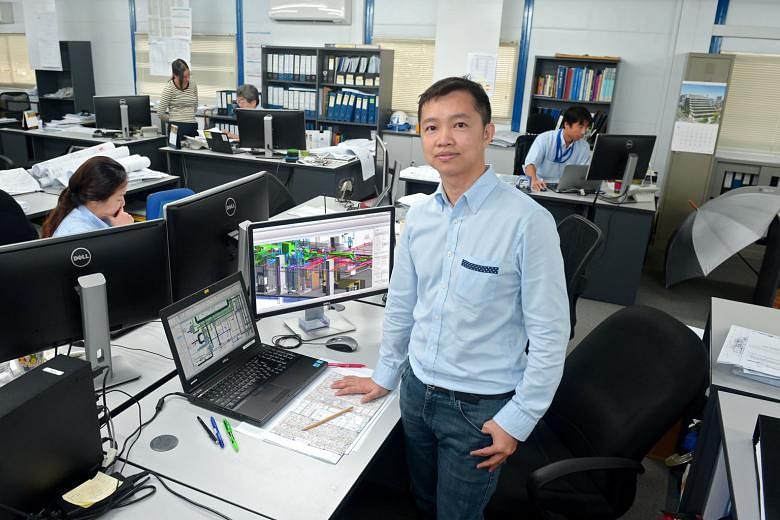Pillars getting in the way of ceiling cables, water pipes clashing with electrical wires - Mr Yip Shaw Chong has seen many such mistakes on construction sites.
Such errors might require cables to be rerouted or walls to be hacked, wasting resources and time and jeopardising the schedules which Mr Yip oversees as senior project manager at Shimizu Corporation's Singapore office.
"Traditionally, we had drawings for each trade," he explains, one set of technical drawings showing electrical works, another showing water pipes, another the walls, and so on.
"Of course, an experienced guy would be able to layer them together and visualise that they will clash. But, inevitably, somebody misses something, there's a clash on site and somebody has to go and fix it."
Today, however, spotting such errors can easily be done by a beginner, or even a computer program. This is thanks to the rise of Building Information Modelling (BIM), a data-heavy virtual 3D-modelling technology that the industry has been increasingly pushed to adopt since the start of the decade.
Since last July, all building plans for new projects with a gross floor area of 5,000 sq m and more have had to be submitted in BIM format for regulatory approval.
The great advantage of BIM software is that it can combine all plans - architectural, engineering, and mechanical and electrical (M&E) - into one integrated model.
"Before, you looked at the 2D drawings, this floor and this floor, and then you tried to visualise whatever intersections there were," says Mr Yip. "Whereas now, you have a model, so it's easier to see clashes."
Recent versions of software are even able to automatically spot and highlight these conflicts.
NEW WAYS OF SEEING
Admittedly, a lot of work must be done upstream to save time on site.
-
Fast Forward series
-
With Singapore firmly focused on the Future Economy, The Straits Times' series, Fast Forward: Disruption and the Singapore Economy, helps you make sense of the big shifts that will shake up entire sectors, reshape jobs and change lives. Every Saturday for 12 weeks, the paper's journalists will examine a disruptive force, its likely impact on the economy and how soon that will be felt. From robotics, 3D printing and smart buildings to dire demographic trends, the global skills revolution and the Asean growth story.
Next week, find out more about green technology and survival as a small state.
In the past, Mr Gan Chee Meng dealt simply with lines and angles in 2D drafting software. Now, as a BIM manager at Shimizu, he grapples with more dimensions.
BIM models are not just 3D drawings. Instead, they are created element by element: a specific size of prefab wall here, a door from a particular manufacturer there. A draughtsman must now incorporate all sorts of data into their model, from warranty details to the contact number of a manufacturer.
Further up the timeline, architects have had to become more precise as well, says RSP Architects Planners and Engineers director Vivien Heng: "We've had to now do very clear designs upfront and go much deeper into our designs."
Previously, an architect could draw a facade lattice, say, without worrying too much about structure. But BIM requires them to think about how the struts fit together, creating a model that structural engineers can use to calculate the forces and stresses involved.
"It's a lot of extra work," Ms Heng sums up.
Yet a data-heavy approach can also make the architect's job easier.
"Traditionally, in the design process, you might just look at a few options," says Associate Professor Patrick Janssen from the National University of Singapore's department of architecture. But the right computer code can generate thousands of possible options, and each one can be simulated and analysed.
Take The Interlace condominium in Depot Road, which consists of 31 horizontal blocks stacked at various angles.
In one of Dr Janssen's research projects, various configurations were generated, and simulations ran to see how well each one performed in terms of daylight, heat from the sun, and so on. This research was for a completed project, but a similar process could be used to plan new projects, he says.
At RSP, the digital exploration of options is already being done on a smaller scale, says Ms Heng. "We use it to explain a specific decision to the client."
For instance, in a project involving two side-by-side auditoriums, a crowd simulation was used to show a client why human traffic would flow better if the auditoriums' exits were on opposite sides.
"Something like this couldn't have been done previously," says Ms Heng. "If you just show the 2D plans and talk, the client can't visualise it, and he's just relying on you to explain it. But now, this can be a truly joint decision, a collaboration."
DO OR DIE
Digital tools are not just a "nice-to-have option", says Building and Construction Authority (BCA) chief executive John Keung.
The lean, waste-reducing approach that BIM and other digital technologies make possible is what Singapore's construction industry needs to survive, he argues.
Studies in the United States and Britain show that 10 to 30 per cent of the time and manpower used in a typical construction project is actually wasted, he points out.
Labour costs there are much higher, providing a huge incentive to cut waste. But costs will not stay low in Singapore either - and manpower supply here will also shrink.
"So, sooner or later, our key decision makers in the industry, CEOs and so on, will understand that if you don't go through this lean process, then you're asking for trouble, you're going to pay a lot more."
In many industries, one fear is that technology will put workers out of jobs. In Singapore's construction sector, getting by with fewer workers is precisely the point. As source countries such as China develop, fewer foreign workers - on which the construction industry depends - will come here.
The sector must thus lessen its reliance on foreign workers while becoming more attractive to local job-seekers, and Dr Keung thinks that digital technologies will help.
After all, the younger generation has grown up with the Internet, computers and 3D games, he notes. "So, for them, it's probably much easier to make the adjustment to 3D BIM.
"I'm actually quite hopeful that this will get quite a bit of traction with the youngsters. And these are very high-value jobs."
That is not to say that older workers will lose their jobs. Of over 8,000 workers that the BCA has trained in BIM so far, many are mid-career professionals.
Experienced draughtsmen are valuable, even as they must retrain from 2D to 3D, adds Mr Gan. "Experience matters, not just in drawing or modelling, but because they need to understand how the models they create are used on site."
CLEANER WAYS TO BUILD
But data-driven tools are just one way in which technology is changing the industry. Just as important is the push for the construction sector to become more like manufacturing, says Dr Keung.
Known as Design for Manufacturing and Assembly (DFMA), this approach involves much more prefabrication, not just of single components like walls and columns, but hybrid parts combining steel and concrete, or even entire rooms. Less work is required on-site, saving man-hours and time, and reducing disruptive noise and dust.
Countries such as Britain also found it easier to get locals to enter the industry, working in factories instead of on sites, and Dr Keung hopes this could happen here too.
With the high degree of automation in factories, workers would be working with machines rather than their hands, he points out. "Manpower is going to be tight, so we must resdesign our jobs to give high-value jobs to whoever is in the industry, especially locals," he concludes. "If we don't do that, we are really going to face a big problem in the next five, 10, 15 years."


